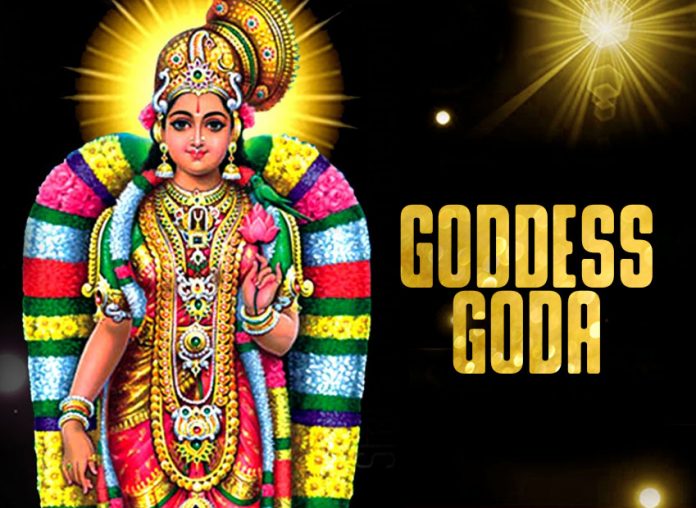Godambika Devi
Godambika Devi or Goda Devi or Andal as popular in Tamil Vaishnava Tradition are the names of the same great person. Godambika was the only female of Vaishnava Dharma among the 12 alwars or azhwars. She was praised as the human incarnation of Goddess Bhudevi as a little baby found in the Tulasi Garden at Sri Villiputtur having not been born from any mother’s womb. Vishnuchitta or Periyalwar while collecting Tulasi leaves for preparing garlands to Lord Vishnu’s worship found this female baby in the Tulasi Garden brought home and started nourishing. Thus she was brought up as the daughter of Vishnuchitta.
Since her childhood she had been a staunch devotee of Lord Vishnu. She took worshiping Lord Vishnu as the only prime duty of her life. While she was growing she used to bedeck her hair with the garlands to be offered to the God Vishnuchitta who had no knowledge of this used to offer those garlands to the God Vishnu. One day he saw the hair of his daughter on a garland and worried badly. He observed fasting for the mistake done. Then he had a dream in which Sri Ranganatha Swami (an aspect of Lord Vishnu) asked him to offer the garlands to Him everyday only after Godambika bedecks them first. It became a practice in the Temple ever since to offer the garlands in that manner only. Then onwards she was called Amuktamalyada in Sanskrit and Cudikodutta nacchiyar in Tamil. Godambika’s devotion and love for Lord Vishnu were growing stronger and stronger. She had a strong desire to be the spouse of Sri Mahavishnu (Vatapatra Sayi) of Sri Villiputtur. Hence she decided to perform a one-month length austerity worshipping Lord Vishnu just as the Gopikas performed Katyayani Vrata in the Dvapara Yuga to procure Sri Krishna as their husband. The day she began the austerity was the first day of Dhanurmasa. Thus during those 30 days she wrote 30 Pasurams in praise of Sri Maha Vishnu. At the end of the 30th day Sri Ranganatha graced and accepted her hand in marriage. Thus she became the spouse of Sri Ranganatha Swami. The thirty pasurams wrote by her occupied a very prominent place among the four thousand PASURAMS written by all the 12 Alwars.
TIRUPPAVAI VRATAM at TIRUMALA
Since that day in all the Vaishnava Temples a festival has been celebrated for Thirty Days in the entire Dhanurmasa by name TIRUPPAVA which means “The Austerity of the Divine Goddess”. As in all the other traditional Vaishnava temples in the Tirumala Temple also this TIRUPPAVAl is grandly celebrated. As a part of these celebrations at Tirumala the early morning instead of Suprabhata the recitation of the Tiruppavai Pasurams of Sri Godambika is done in the Sanctum Sanctorum. On the bosom of Sri Venkateswara Swami just by the side of the small idol of Sridevi a golden parrot is decorated in all the thirty days of Dhanurmasa.
NIRATTOTSAVAM AT TIRUPATI SRI GOVINDARAJASWAMI TEMPLE
While Dhanurmasa is celebrated on the Tirumala hill in this manner the Nirattotsavam is celebrated as a part of Dhanurmasa festival at Sri Govindarajaswami Temple at Tirupati Nirattotsavam is an annual festival performed for seven days before to the annual BHOGI festival.
The NIRATTAM means ABHISHEKA or Sacred bath to the Goddess. The sequence of the daily events in the seven day festival is performed in the following manner. After the early morning Dhanurmasa Puja at the Govindarajaswami Temple, the idol of Godambika is brought out in a beautifully decorated Palanquin to the banks of the Ramachandra Pushkarini through the holy streets surrounding the Govindaraja Swamy temple. There on an elevated platform of Niratta Mandapa, Goddess Godambika is seated to be visible to all the devotees and start the performance of Nirattam (Abhishekam) with sacred waters, cow milk and other panchaamritam reciting various Suktams like Sri Sukta, Bhu Sukta, Nila Sukta etc. After Nirattam or Abhisheka the priests offer Naivedyam or Sacred Food to the Goddess. Then Sattumora prayers are recited followed by the Divine Assembly called Asthanam. This process goes till the evening. In the evening, Goddess Godambika is well decorated with flower garlands and seated in the Tirucchi vahanam. A procession starts from the Ramachandra Pushkarini through the holy streets and the Goddess is brought back to the temple of Sri Govindarajaswami while the Vedic scholars chant Vedic hymns and the musicians play on various instruments throughout the procession. In this manner this NIRATTOTSAVAM is celebrated for seven days.
BHOGI TERU
On the eighth day i.e., BHOGI which is the previous day to Makara Sankranti the BHOGI TERU festival is performed with festive fervour. As a part of this festival the well ornamented idols of Sri Godambika and Sri Krishna Swami are seated in a beautifully decorated Chariot and a procession is led around the sacred streets around the Holy Temple of Sri Govindarajaswami.
The Nirattotsavam and Bhogi Teru together is a nine day festival in all the Vaishnava Divya Desams. But in the Govindarajaswami temple of Tirupati, this is celebrated for eight days of which in the first seven days the Nirattotsavam is celebrated and on the eighth day Bhogi Teru is celebrated.
With the advent of Makara Sankramanam the holy Dhanurmasa comes to an end and the Makaramasa begins.
CHAKRA SNANAM AND PROCESSION OF THE DEITIES
In the morning hours of MAKARA SANKRANTI day, the Sacredbath is performed to Sri Chakrattalwar in Alwar Tank at Kapila Tirtham. In the evening a procession of the deities Sri Godambika and Sri Krishna Swami is led in the holy streets of Sri Govindarajaswami temple.
Read More About Goda Devi Kalyanam




[…] grand celebration of the Divine Kalyanam of Sri Godambika with Sri Krishna Swami is performed on the day of KANUMA, the next day to Makara Sankranti in the […]